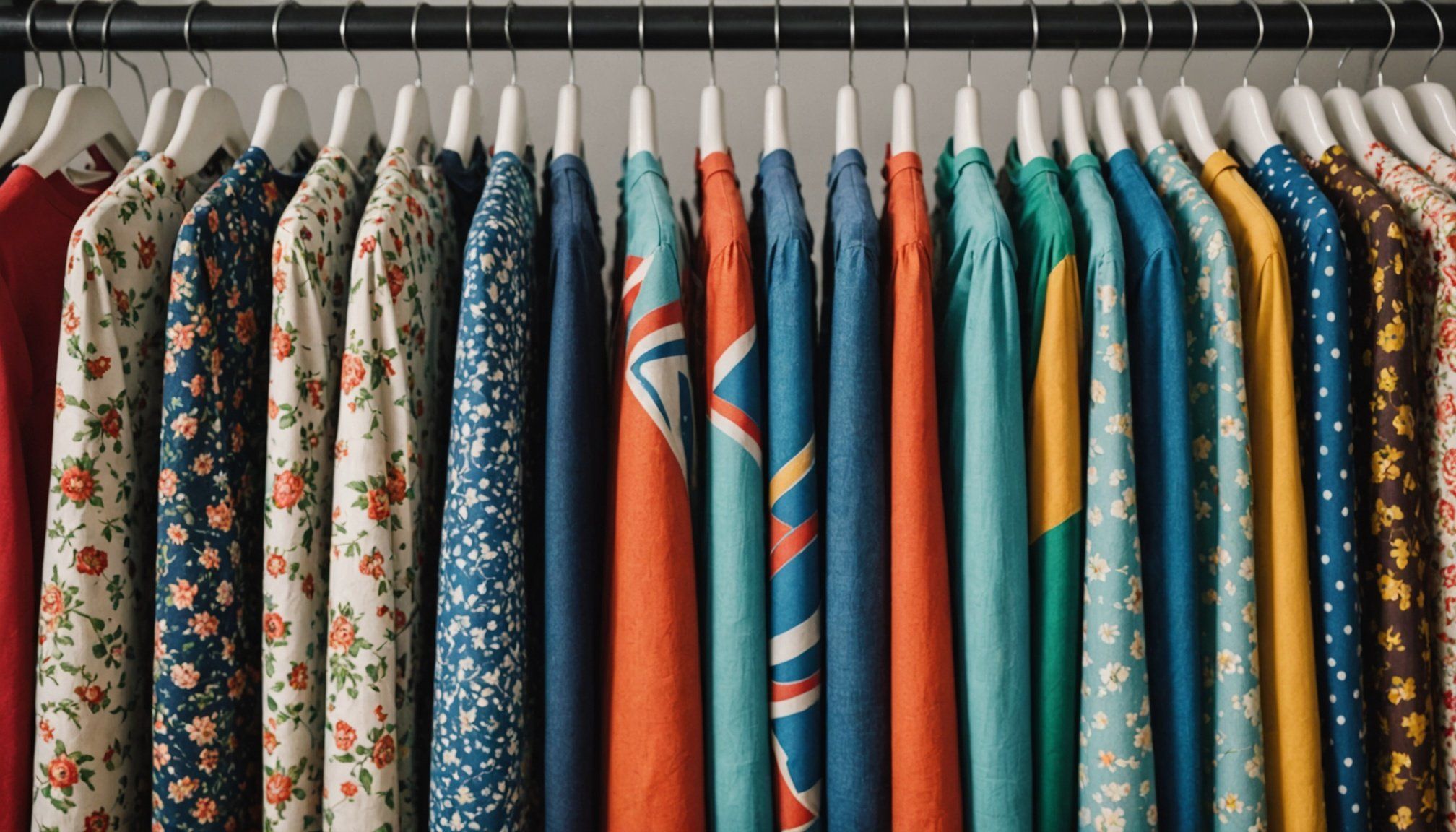The Ultimate Guide to Choosing the Perfect Fabric Conditioner for Preserving Vintage Clothing in the UK
Preserving vintage clothing is an art that requires careful attention to detail, especially when it comes to the fabrics and the conditioners used to maintain them. Whether you’re a collector, a fashion enthusiast, or simply someone who values the uniqueness of vintage items, choosing the right fabric conditioner is crucial. Here’s a comprehensive guide to help you make the best decisions for your precious vintage clothes.
Understanding Your Fabrics
Before diving into the world of fabric conditioners, it’s essential to understand the types of fabrics you’re dealing with. Vintage clothing can be made from a variety of materials, including cotton, wool, tweed, and leather.
This might interest you : Create your perfect capsule wardrobe for the uk”s changing climate: a complete guide
Cotton and Organic Cotton
Cotton is one of the most common fabrics in vintage clothing. It’s breathable, durable, and relatively easy to care for. However, cotton fabrics can become dry and brittle over time. For cotton and organic cotton items, look for conditioners that are gentle and free from harsh chemicals. Organic cotton fabrics, like those from CastleWare, are particularly sensitive and require conditioners that are chemical-free and safe[3].
Wool and Tweed
Wool and tweed fabrics are known for their warmth and texture. These fabrics can be more delicate and may require special care. When conditioning wool or tweed, it’s important to use products that maintain their natural oils without weighing them down. British brands often prioritize high-quality fabrics like wool and tweed, ensuring they remain soft and durable over time[1].
Topic to read : Uncover top vegan beauty brands available in the uk: a complete guide for conscious consumers
Leather
Leather items are a staple in many vintage collections. Leather requires specific care to prevent drying out and cracking. Mink oil is a popular conditioner for leather, as it replenishes the natural oils lost during use and lubricates the fibers, making them more flexible and durable.
“Mink oil was the conditioner of choice to re-saturate that leather, prevent it from drying out and cracking. So it just adds that moisture. That gives you a longevity of leather,” says Weston Kay, a leatherworker and YouTuber at Rose Anvil[2].
Choosing the Right Fabric Conditioner
The right fabric conditioner can make a significant difference in the longevity and appearance of your vintage clothes.
For Cotton and Organic Cotton
For cotton and organic cotton fabrics, you want a conditioner that is gentle and non-toxic. Here are a few tips:
- Hand Washing: Always hand wash cotton and organic cotton items in cold water to prevent damage.
- Mild Detergents: Use mild detergents that are free from harsh chemicals.
- White Vinegar: Adding a small amount of white vinegar to the wash can help maintain the fabric’s original color and softness.
For Wool and Tweed
Wool and tweed fabrics require conditioners that are specifically designed for these materials. Here are some considerations:
- Avoid Machine Washing: Wool and tweed should never be machine washed, as this can cause shrinkage and damage.
- Cold Water: Hand wash these fabrics in cold water using a mild detergent.
- Air Dry: Always air dry wool and tweed items, avoiding direct sunlight which can cause fading.
For Leather
Leather conditioners are specialized and can vary depending on the type of leather.
- Mink Oil: As mentioned, mink oil is excellent for conditioning leather, but it can darken the leather over time.
- Alternative Conditioners: Products like Bickmore Bick 4 and Obenauf’s Heavy Duty LP are great alternatives that condition and protect leather without darkening it[2].
Detailed Guide to Popular Fabric Conditioners
Here is a detailed look at some popular fabric conditioners, including their pros and cons:
Mink Oil
- Pros:
- Replenishes natural oils in leather.
- Softens and lubricates leather fibers.
- Extends the lifespan of leather items.
- Cons:
- Can darken the leather over time.
- Not suitable for all types of leather.
Bickmore Bick 4
- Pros:
- Preserves the original color of the leather.
- Conditions, cleans, and protects leather without darkening it.
- Extends the lifespan of leather items.
- Cons:
- Does not deeply penetrate the pores of the leather.
- Does not improve water resistance as much as mink oil.
Obenauf’s Heavy Duty LP
- Pros:
- Contains beeswax and natural nourishing ingredients.
- Protects the leather from moisture and keeps natural oils in.
- Suitable for chrome-tanned leather.
- Cons:
- Best used on specific types of leather (chrome-tanned).
- May not be as effective for oil-tanned or vegetable-tanned leather.
Table: Comparing Popular Leather Conditioners
| Conditioner | Key Ingredients | Pros | Cons |
|---|---|---|---|
| Mink Oil | Mink fat | Replenishes natural oils, softens leather, extends lifespan | Can darken leather, not suitable for all leather types |
| Bickmore Bick 4 | Natural emulsifiers, conditioners, moisturizers | Preserves original color, conditions and protects without darkening | Does not deeply penetrate pores, does not improve water resistance |
| Obenauf’s Heavy Duty LP | Beeswax, natural oils | Protects from moisture, keeps natural oils in, suitable for chrome-tanned leather | Best used on chrome-tanned leather, may not be effective for other types |
| Obenauf’s Oil For Moderate Conditions | Beeswax, natural oils | Hydrates leather, heals cracks, suitable for oil-tanned and vegetable-tanned leather | May not be as effective for chrome-tanned leather |
| Saphir Renovateur | Mink oil, waxes | Conditions, shines, produces soft patina, does not darken leather | Not a full alternative to mink oil, contains a mix of ingredients |
Practical Tips for Conditioning Vintage Clothes
Here are some practical tips to help you condition and care for your vintage clothes effectively:
Hand Washing
- Always hand wash delicate or vintage items in cold water to prevent damage.
- Use a mild detergent that is free from harsh chemicals.
Avoiding Direct Sunlight
- Direct sunlight can cause fading and damage to fabrics. Always air dry items away from direct sunlight.
Using White Vinegar
- Adding a small amount of white vinegar to the wash can help maintain the fabric’s original color and softness.
Freezing to Reduce Shedding
- For hairier yarns or fabrics, freezing the garment can help reduce shedding. Place the garment in a plastic bag and put it in the freezer for a few hours before shaking it vigorously and washing it according to the instructions[5].
Avoiding Machine Washing
- Machine washing can be too harsh for many vintage fabrics. Always opt for hand washing or dry cleaning if necessary.
Anecdotes and Examples
Preserving a Vintage Leather Jacket
Imagine you have a vintage leather jacket that has been passed down through generations. To preserve it, you would use mink oil to condition the leather, ensuring it remains soft and flexible. However, if you’re concerned about the leather darkening, you might opt for Bickmore Bick 4 instead.
Caring for a Wool Sweater
For a vintage wool sweater, hand washing in cold water with a mild detergent is crucial. After washing, gently squeeze out excess water and lay the sweater flat to air dry. Avoid hanging it up, as this can cause stretching.
Preserving vintage clothing is a meticulous process that requires the right tools and knowledge. By understanding the types of fabrics you’re working with and choosing the appropriate conditioners, you can extend the life of your vintage items and keep them looking their best.
Remember, the key to preserving vintage clothes is to be gentle and patient. Always read the labels, follow the care instructions, and use conditioners that are specifically designed for the type of fabric you’re dealing with. With the right care, your vintage clothes can remain timeless and beautiful for generations to come.
Final Tips and Recommendations
- Read Care Labels: Always read the care labels on your vintage clothes to understand the best cleaning methods.
- Use High Quality Conditioners: Invest in high-quality conditioners that are designed for your specific fabric types.
- Avoid Harsh Chemicals: Steer clear of harsh chemicals and detergents that can damage your fabrics.
- Consult Professionals: If you’re unsure about the best way to care for a particular item, consult a professional dry cleaner or restorer.
By following these guidelines and using the right fabric conditioners, you’ll be well on your way to preserving your vintage clothing and ensuring they remain in excellent condition for years to come.
Understanding Vintage Fabrics
Identifying fabric types in vintage clothing is crucial for proper care and maintenance. Different materials require specific handling techniques, making it essential to recognize the fabric before attempting any preservation.
When exploring vintage fabric care, it’s common to encounter materials like cotton, silk, wool, and polyester. Each possesses unique properties that demand varied care approaches. For example, cotton is known for its sturdiness and breathability, while silk provides a luxurious feel but needs gentle handling. Wool is warm and resilient, often requiring special cleaning methods, whereas polyester is durable and relatively easy to care for.
To ensure effective textile preservation, differentiating between delicate and sturdy fabrics is vital. Delicate fabrics, such as lace or chiffon, should be treated with utmost caution, often requiring handwashing and air-drying techniques to maintain their integrity. On the other hand, sturdy fabrics like denim or heavy wool can typically withstand more intensive cleaning practices.
Understanding these differences not only helps in maintaining the garment’s condition but also preserves its historical and aesthetic value. By recognizing the distinct properties of each vintage fabric type, one can make informed decisions that prolong their lifespan and beauty.
Importance of Fabric Conditioners for Vintage Clothing
Delving into fabric conditioner benefits, these products are pivotal for the care of vintage clothing. They play a significant role in maintaining the integrity of delicate fabrics, ensuring that these precious garments remain robust and wearable over time. Fabric conditioners achieve this by lubricating and softening the fibres, reducing friction and potential damage during washing.
A crucial benefit of conditioning agents is their contribution to the longevity of vintage clothing. By carefully preserving the fibre and colour condition, they help slow down the aging process and maintain the garment’s original allure. This preservation is essential for vintage clothing collectors and enthusiasts who wish to maintain the value and aesthetic appeal of their unique pieces.
Moreover, fabric conditioners significantly influence the texture and feel of delicate fabrics. Treated garments are left feeling softer and more pleasing against the skin, enhancing the wearability and comfort of these sometimes sensitive textiles. It’s essential, however, to choose fabric conditioners that are specifically formulated for delicate or vintage materials to avoid any potential adverse effects.
Compatibility of Fabric Conditioners with Vintage Fabrics
Understanding fabric compatibility is essential when using fabric softeners on vintage textiles. The delicate nature of these materials requires attentive care to avoid damage.
When assessing whether a softener is safe for vintage fabrics, consider the fibre content. Natural fibres such as cotton and silk are often found in older garments and might react negatively with harsh chemicals. Read product labels to ensure they are suitable for specific fibres. Modern fabric conditioners might contain ingredients that break down natural fibres over time.
The impact of using an incompatible softener can be detrimental, leading to fading or weakening of the fabric, which may result in irreversible damage. Always perform a patch test on a hidden area before applying any product widely. Understanding these risks ensures the preservation of the fabric’s integrity and appearance.
For safe use, look for conditioners advertised as gentle or specifically designed for vintage textiles. Products with phrases like “for delicates” or “hypoallergenic” generally offer a milder formulation. Molly’s Suds Fabric Softener or Seventh Generation offer environmentally friendly options that cater to sensitive materials, minimising potential harm to your treasured items. Such choices help maintain both the quality and longevity of your vintage collection.
Recommended Fabric Conditioners for Vintage Clothing
Finding the top fabric conditioners in the UK market that cater to vintage clothing can be daunting. However, several reputable UK brands stand out for their dedication to gentle care, ensuring even the most delicate garments remain pristine. British brands like Ecover and Method are praised for using natural ingredients that not only cleanse but also protect fabrics.
Key Features and Ingredients
When selecting a fabric conditioner, focus on ingredients such as plant-based compounds and mineral enhancements that provide softness without the harshness of chemicals. These key features often contribute to enhanced fabric longevity, essential for vintage clothes. Aromatic formulas are also common, offering pleasant scents while giving garments a fresh feel.
User Reviews and Ratings
Product reviews are invaluable when deciding on the best option. Many users commend Ecover’s products for their environmental friendliness and gentle formulation. Method also receives high praise for its vibrant scents and sustainable packaging. High ratings across various platforms suggest satisfaction from users who seek both quality and eco-consciousness. A consistently high user rating often indicates a reliable choice, providing confidence in your fabric care routine.
Choosing a product that meets these criteria can make your vintage items last even longer while keeping them soft and fragrant.
Application Tips for Using Fabric Conditioners on Vintage Clothing
When caring for vintage clothing, proper conditioning techniques are essential to maintain fabric integrity. Begin with a step-by-step approach:
-
Dilution: Always dilute fabric conditioners to prevent residue buildup. For delicate vintage materials, a 1:10 ratio of conditioner to water is advisable.
-
Application methods: Use a spray bottle for an even distribution. Mist the solution lightly over the garment from a distance of approximately 30 centimeters, ensuring not to saturate the fabric.
-
Fabric care: Test the conditioner on a hidden area first to check for adverse reactions. This step is crucial as vintage fabrics can be sensitive to modern products.
Dos and Don’ts
- Do: Use cold water when diluting, as it helps prevent fibre weakening.
- Don’t: Apply conditioners directly onto the fabric without dilution.
- Do: Allow the garment to air dry naturally in a shaded area.
Application frequency depends on the fabric’s condition and usage. Generally, apply the conditioner after every few wears, or monthly for items not frequently used. By following these guidelines, your vintage attire can continue to look its best, prolonging its lifespan.
Environmental Considerations and Eco-Friendly Options
When it comes to caring for vintage fabrics, opting for eco-friendly fabric conditioners is crucial. These conditioners ensure the longevity of delicate textiles while being gentle on the environment. In the UK, there is an increasing array of sustainable choices available. Brands like Ecover and Method offer biodegradable and non-toxic solutions specifically designed for vintage care.
Using sustainable fabric conditioners benefits not just the garments but also our planet. These products break down naturally, reducing pollution both in water systems and landfills. They are designed to be environmentally safe, ensuring no harmful chemicals seep into ecosystems.
Some key advantages of choosing eco-friendly options include:
- Biodegradability: These conditioners decompose quickly, lessening environmental impact.
- Non-Toxicity: Safe for skin contact and does not release harmful substances.
- Fabric Longevity: Maintains the quality and texture of vintage materials without the use of harsh chemicals.
Selecting sustainable fabric care options intertwines the preservation of cherished vintage pieces with a commitment to ecological respect. Embracing eco-friendly practices highlights the importance of conscious consumerism in clothing care, ensuring a smaller environmental footprint.
Comparing Fabric Conditioners: Performance and Safety
When performing a fabric conditioner comparison, several criteria must be considered. Key factors include the product’s ability to soften textiles, reduce static cling, and impart a pleasant fragrance. Critical among these is the effectiveness of each conditioner, which determines how well they perform these tasks. Consumer reports often highlight products that deliver noticeable softness and scent longevity without overwhelming the user.
Safety is paramount, especially for those dealing with delicate or vintage textiles. When selecting a fabric conditioner for such items, it’s essential to consider the formula’s chemical composition. Products should be free from harsh chemicals and dyes to prevent potential damage or discoloration. Some conditioners are specifically marketed for their gentleness, making them suitable for sensitive fabrics.
Comparative studies or consumer feedback provide invaluable insights into both performance and safety. These often reveal trends, such as biodegradable or hypoallergenic options gaining favor among users. Feedback also indicates consumer satisfaction with conditioners that balance effectiveness with minimal environmental impact. By considering these findings, one can make an informed choice that aligns with both performance needs and safety considerations.
Additional Tips for Preserving Vintage Clothing
Vintage clothing offers a timeless charm, but caring for it requires specialized attention. Mastering the art of vintage preservation begins with employing effective storage solutions. Store items in a cool, dry environment to prevent degradation. Avoid direct sunlight to maintain vibrant colours over time. Sturdy, padded hangers provide support, reducing stress on fabric, while breathable garment bags shield against dust and pollutants.
It’s equally important to use appropriate cleaning methods. Always test cleaning products on a small, inconspicuous portion of the fabric to ensure compatibility. For optimal results, combine these methods with a gentle fabric conditioner to maintain softness and resilience. Hand washing in lukewarm water often proves to be the most gentle approach, especially for delicate materials like silk or lace.
Regular upkeep is paramount for the longevity of vintage clothing. Inspect garments routinely for signs of wear and tear, such as loose seams or small holes. Addressing these issues promptly can prevent further damage. Lastly, rotate items in storage to ensure even exposure and omit the effects of prolonged pressure points, promoting fabric health over time.











